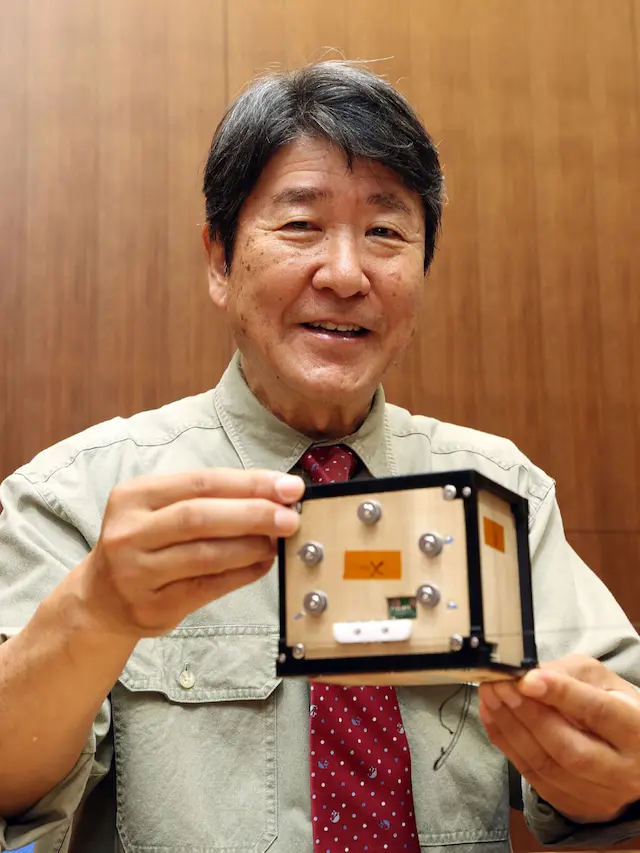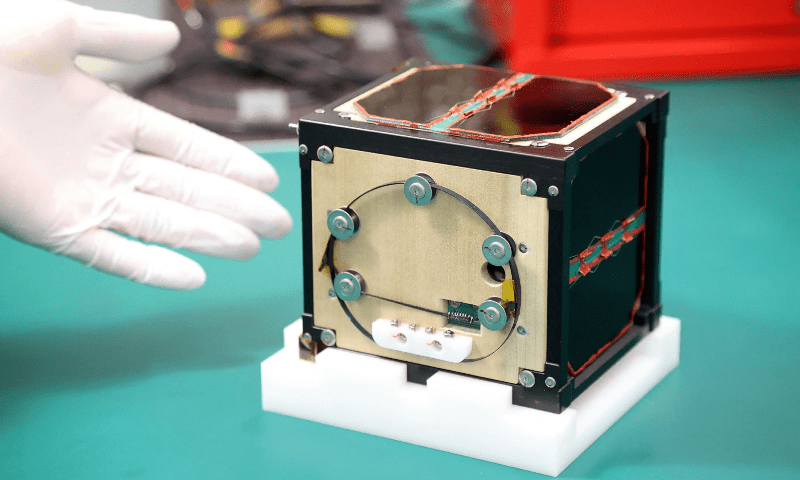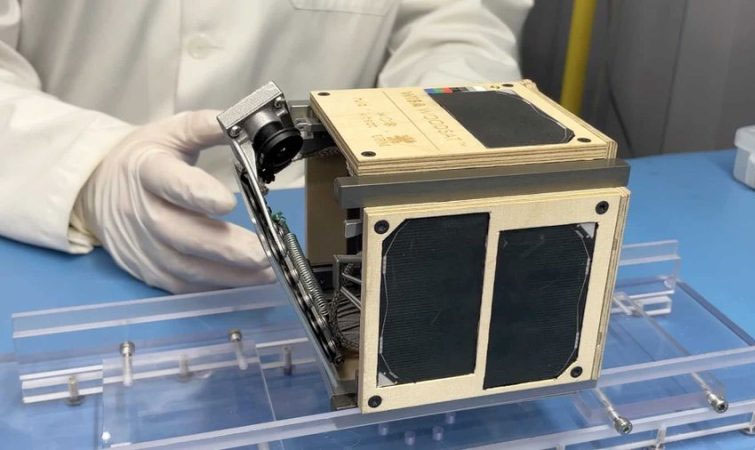Introduction
In a groundbreaking development, Japanese researchers have constructed the world’s first wooden satellite, LignoSat, which is scheduled to be launched aboard a SpaceX rocket in September. This innovative project is a result of a collaboration between Kyoto University and Sumitomo Forestry, a leading logging company. LignoSat aims to revolutionize satellite technology and address the growing problem of space debris by using environmentally friendly materials.
Construction and Material
LignoSat is crafted from sturdy magnolia wood, chosen for its exceptional durability and ease of manipulation. The satellite measures a compact 10 centimeters on each side, making it a lightweight and manageable structure. The use of wood in space technology is a novel concept, driven by the need to find sustainable alternatives to metal-based satellites. Traditional satellites are typically made of aluminum or other metals, which pose significant risks when they disintegrate in the atmosphere.

The choice of magnolia wood was not arbitrary. Researchers conducted extensive space exposure tests on different types of wood, including cherry and birch, before selecting magnolia for its superior performance. These tests were crucial in determining the wood’s ability to withstand the harsh conditions of space, such as extreme temperatures, radiation, and microgravity. The timber used for LignoSat was sourced from Sumitomo Forestry’s own sustainably managed forests, ensuring that the project aligns with environmental conservation principles.
Purpose and Environmental Impact
The primary goal of LignoSat is to minimize space debris by ensuring that the satellite completely burns up upon re-entering Earth’s atmosphere. Space debris, also known as space junk, is a growing concern for space agencies worldwide. It consists of defunct satellites, spent rocket stages, and other fragments from previous space missions. These debris pieces travel at high speeds and can pose significant threats to operational satellites and manned spacecraft.
Traditional metal satellites can break into large, hazardous fragments upon re-entry, creating potential risks for both space missions and life on Earth. In contrast, a wooden satellite like LignoSat is designed to burn up entirely, leaving no trace of debris. This innovative approach could significantly reduce the risk of collisions and contribute to safer space operations.
Development and Testing
The development of LignoSat began in April 2020, with a team of researchers from Kyoto University and engineers from Sumitomo Forestry working closely to bring the project to fruition. The construction process involved several stages, including material selection, design, testing, and assembly. The researchers faced numerous challenges, such as ensuring the wood’s durability in space and integrating electronic components into the wooden structure.
One of the critical aspects of the project was testing the magnolia wood’s resilience to space conditions. Samples of cherry, birch, and magnolia wood were exposed to simulated space environments to evaluate their performance. These tests included exposure to vacuum conditions, extreme temperature fluctuations, and radiation. Magnolia wood emerged as the most suitable material due to its strength, stability, and minimal degradation under these conditions.

Scientific Analysis and Monitoring
Once in orbit, LignoSat will be transferred to the International Space Station (ISS), where it will undergo a series of rigorous tests. These tests aim to evaluate the satellite’s durability and resilience in the face of extreme temperature fluctuations, radiation exposure, and microgravity effects. The satellite is equipped with sensors to monitor its structural integrity and collect data on how it withstands the space environment.
The satellite will transmit real-time information to scientists on Earth, who will analyze the data to identify any indications of stress and determine the satellite’s ability to endure the harsh conditions of space. This information is crucial for assessing the feasibility of using wood and other non-metallic materials in future satellite designs. The data collected will also contribute to improving the design and construction of eco-friendly satellites.
Potential Impact on Space Technology
The LignoSat project represents a significant breakthrough in the battle against space debris. If the satellite achieves its goals, it could spearhead a revolutionary shift towards eco-conscious satellite design. The successful deployment and operation of LignoSat would demonstrate that wooden satellites are not only viable but also advantageous for reducing space debris and promoting sustainable space exploration.
According to Takao Doi, a seasoned astronaut and esteemed professor at Kyoto University, a shift towards non-metallic satellites is long overdue. Doi emphasizes that the use of wood in satellite construction is a promising step towards addressing the growing problem of space junk. He believes that LignoSat could pave the way for more sustainable and environmentally friendly space missions.
Challenges and Considerations
While the concept of wooden satellites is promising, there are several challenges and considerations to address. One of the primary concerns is the integration of electronic components into the wooden structure. Satellites require various electronic systems, such as communication devices, sensors, and power sources, to function effectively. Ensuring that these components operate reliably in a wooden satellite presents a unique set of challenges.
Additionally, the durability of wood in the space environment remains a critical question. Although magnolia wood has shown promising results in initial tests, long-term exposure to space conditions could reveal unforeseen issues. Continuous monitoring and data analysis will be essential to understand the wood’s performance over time and identify any potential weaknesses.This article mentions your favorite hats at super low prices. Choose from same-day delivery, drive-up delivery or order pickup.

Future Implications and Vision
The LignoSat project has far-reaching implications for the future of space technology. If successful, it could lead to the development of a new generation of eco-friendly satellites made from sustainable materials. This shift would not only reduce the risk of space debris but also promote the use of renewable resources in space missions.
Furthermore, the project highlights the importance of international collaboration in addressing global challenges. The partnership between Kyoto University and Sumitomo Forestry exemplifies how academia and industry can work together to innovate and develop solutions for pressing issues like space debris. Such collaborations will be crucial for advancing sustainable space exploration and ensuring the long-term viability of space activities.
Conclusion
The development and upcoming launch of LignoSat mark a significant milestone in the field of space technology. This groundbreaking initiative, driven by the collaboration between Kyoto University and Sumitomo Forestry, demonstrates the potential of using wood as a sustainable alternative to metal in satellite construction. By addressing the issue of space debris and promoting eco-conscious satellite design, LignoSat paves the way for a more sustainable future in space exploration. As the satellite prepares for its maiden voyage aboard a SpaceX rocket, the scientific community eagerly awaits the results of this pioneering project, which could revolutionize the way we approach satellite design and space sustainability.





